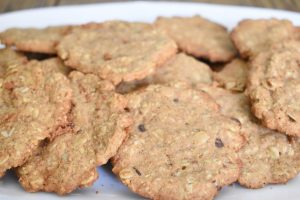 Gluten is the name for one of the proteins that is found in wheat, barley, and rye as well as specialty wheat such as triticale and spelt. These proteins such as those found in wheat flours make dough elastic and stretchy. This elasticity also traps gas within baked goods, which provide a light airy structure.
Gluten is the name for one of the proteins that is found in wheat, barley, and rye as well as specialty wheat such as triticale and spelt. These proteins such as those found in wheat flours make dough elastic and stretchy. This elasticity also traps gas within baked goods, which provide a light airy structure.
Who should eat Gluten-Free?
Do you know someone who needs to avoid gluten? There are individuals who have been medically diagnosed with Celiac Disease, gluten sensitivity or gluten intolerance that should eat gluten-free foods. It is very harmful for someone diagnosed with Celiac Disease to eat foods that are made with or contain gluten. Before you decide to eat gluten-free consult with a medical provider.
Some foods are naturally gluten-free (GF) such as fresh produce, eggs, fish, meats, dairy, corn, quinoa, and rice. Today more than in the past there are many types of GF flours and flour blends to use for baking and cooking.
Flours
Blending a combination of gluten-free flours is vital to the flavor, texture, and success in baking. There are four basic flour mixtures that are easy to create and store in sealed containers for use. Creating your own can be a lot of fun but takes some experimenting based on your taste preference.
- All-purpose flour blend (General baking)
- Here is a simple basic blend:
- 24 oz. Brown Rice Flour, 24 oz. White Rice Flour, 24 oz. Sweet Rice Flour, 20 oz. Tapioca Flour (aka Tapioca Starch) – mix well.
- Here is a simple basic blend:
- High fiber blend (breads, pancakes, snack bars)
- High-protein blend (baked goods requiring elasticity)
- Self-rising blend (muffins, scones, cakes and cupcakes)
Binders
When baking you typically will need a binder to help the baked product raise. Common binders used in commercial GF products are xanthan gum, guar gum or tapioca flour. Xanthan gum is typically used in yeast breads (1 tsp per cup of GF flour) and quick breads (1/2 tsp per cup of GF flour). An egg can also function as a binder.
Other baking tips
-
- Add an extra egg, an additional tablespoon of oil or honey to increase moisture

- Enhance flavors using nuts, dried fruits, and spices
- Brown sugar generally works better than white
- When using leavening agents, use 2 tsp baking powder per cup of GF flour.
- Use dull or dark pans for better browning
- Allow dough/batter to rest in the refrigerator for at least 1 hour prior to baking.
- Bake in smaller portions that are easy to eat. This allows you to freeze extra goodies to eat or share later.
- Add an extra egg, an additional tablespoon of oil or honey to increase moisture
For additional resource check out these sites:
- Gluten-Free Baking – https://extension.colostate.edu/topic-areas/nutrition-food-safety-health/gluten-free-baking-9-376/
- Gluten-Free Diet Guide – https://extension.colostate.edu/topic-areas/nutrition-food-safety-health/gluten-free-diet-guide-9-375/
- Should I Go Gluten Free? – https://www.uhs.uga.edu/nutrition/gluten-free
- Celiac Disease Foundation – https://celiac.org/eat-gluten-free/recipes/


Thanks for the baking tips — a couple that I have not yet tried.
Great article. I love all the links to other resources when I’m ready to learn more.